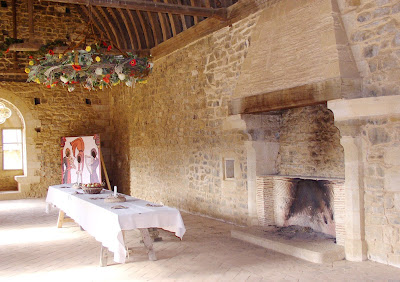In the heart of France, a 2 ½ hour drive from Paris, a team of fifty master-builders have taken on the challenge of building a castle using medieval techniques and materials.Surrounded by Guédelon Forest and all the natural materials required for the construction -- stone, wood, earth, sand, clay – day after day artisans are building a castle from the ground up.
Guédelon Castle, the brainchild of Michel Guyot, was once an abandoned quarry on the outskirts of the village. M. Guyot has not only begun the re-creation of an ancestral French structure, he has fostered a moneymaking tourist attraction as well. In the early stages, he had to secure public and private financing, which probably wasn’t easy, but since 1997, Guédelon has become a medieval building site. Not only is a 13th century castle being built there--it is being built with the materials and building techniques of that age (!) Slow going, you can be sure.
The castle is supposed to be finished in 2025, but because they work only from March to November, and because the tourist business is thriving, I don’t think they are in a hurry to finish the castle. (Also, there is a matter of mortar freezing and cracking in very cold weather.) It is a very popular tourist attraction, mainly for French people, because not many others know about it. Since 1997, millions of visitors have gone to Guédelon--the sheer number of visitors finally answered the question of whether the public would be interested in castle-building in the 21st century. I enjoyed the visit very much, but at the same time, it is such a fascinating project that I want them to hurry up and make more visible progress year over year.
A model of Guédelon Castle
A view of the courtyard of the castle
The Great Tower on the right provides a lookout for approaching enemies. It is the castle’s ultimate stronghold.
The wooden bridge between the towers of the castle will be a fixed bridge. The more complicated drawbridge was reserved for royal castles and the gates of important towns. The vertical openings in the towers are “arrow loops,” from which to shoot arrows.
Guédelon Castle - October, 2017
On the first floor of the North Range (the building between the towers), there is the Great Hall and a bedroom.
Castle courtyard
The crenelated wall provides a vantage point and protection for soldiers protecting the castle. The western flanking tower is on the left. The staircase on the right leads to the castle proper.
Treadwheel winch
Lifting machinery is used to hoist stones and mortar onto the walls and towers under construction. The Treadwheel winch is the crane of the Middle Ages. A worker walks slowly in the “squirrel cage,” and as the wheel turns, the rope wraps around the central axel and the load is hoisted up. Shown is a double-drummed “human hamster wheel.”
A mason at work
The arm of the winch disappears into the top of the photo.
The masons must be very precise. Their walls must be level and their vaults must not collapse. They use a mason’s level to check that masonry is level, a plumb line to check that a wall is upright and a set square to check right angles.
A single treadwheel winch lifts stones and mortar up to the western flanking tower.
The wall-walk runs around the castle, allowing soldiers to move around and keep watch over the surrounding areas. The walk is crenelated so that soldiers can shelter behind the solid part and shoot from the spaces between the crenels.
A closer look at the western flanking tower
A centring is the wooden assembly that supports the masonry of the arch of the tower. It is designed to brace the stones as they are laid to become the arch ceiling. When the arch is complete, the wooden blocks supporting it are knocked away, and the arch stands on its own.
Courtyard as seen from the interior of castle
The Great Hall banquet room
The Great Hall banquet table and fireplace
Hanging flower chandelier above the banquet table
Antechamber (a smaller room serving as an entryway into a larger one) on the first floor, along with the Great Hall
Antechamber mural
Mineral pigments, such as ochre and hematite, are used to carry out mural paintings inside the castle.
Antechamber (a smaller room serving as an entryway into a larger one) on the first floor, along with the Great Hall
Antechamber mural
Mineral pigments, such as ochre and hematite, are used to carry out mural paintings inside the castle.
Window seat in antechamber
Interior corridor in castle
Interior door of castle
“Tip” jar
Workmen’s tip jar, to show appreciation for their workmanship
Quarry and Guédelon Forest
Loading cart
Experienced quarrymen could look at rock and see the weaker layers and split it accordingly, creating pieces of approximately equal size. This seems like very slow going, but it doesn't really matter because all of the construction steps are done in slow motion, judging by modern-day standards.
Horse & cart deliver stones to stone mason
On the right, you can see the whole apparatus of the tread wheel winch.
Cart emptying stones
Quarry horse and new-found friend.
Guédelon horses must not only be strong, but must also have very calm temperaments.
To be Continued:
Guédelon Castle, Part II, describes the work stations and village in the castle complex.




























































